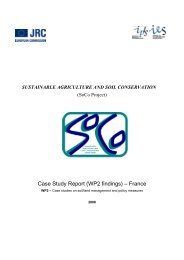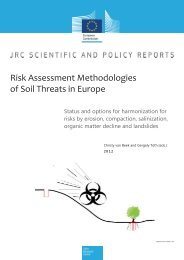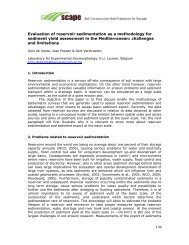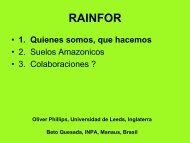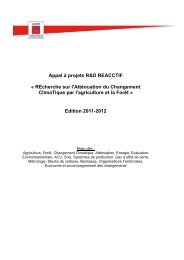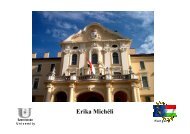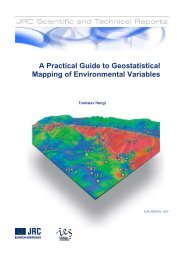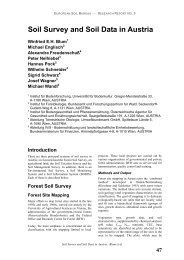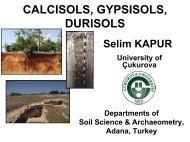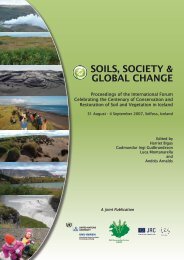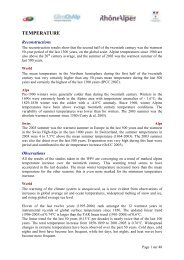SOIL SURVEY IN ALBANIA - European Soil Portal
SOIL SURVEY IN ALBANIA - European Soil Portal
SOIL SURVEY IN ALBANIA - European Soil Portal
Create successful ePaper yourself
Turn your PDF publications into a flip-book with our unique Google optimized e-Paper software.
LUVISOLS<br />
25.3%<br />
CALCISOLS<br />
0.8%<br />
PHAEOZEMS<br />
10.5%<br />
KASTANOZEMS<br />
0.1%<br />
GLEYSOLS<br />
0.5%<br />
SOLONCHAKS<br />
0.4%<br />
FLUVSOLS<br />
5.5%<br />
VERTISOLS<br />
0.5%<br />
EUROPEAN <strong>SOIL</strong> BUREAU ⎯ RESEARCH REPORT NO. 9<br />
LEPTOSOLS<br />
8.8%<br />
HISTOSOLS<br />
0.1%<br />
Figure 2: Distribution of soils according to the WRB<br />
Use of Existing <strong>Soil</strong> Data<br />
Land evaluation of agricultural<br />
potentials<br />
Based upon the soil data accumulated during the<br />
period 1970-1988, the <strong>Soil</strong> Science Institute in<br />
Tirana began in 1988 a Physical Land Evaluation<br />
Study for all the agricultural land of the country.<br />
The main soil characteristics used for this land<br />
evaluation exercise were soil depth, thickness of<br />
the humus horizon, organic matter content at 50cm<br />
depth, available phosphorus, texture, and available<br />
moisture content of the topsoil. <strong>Soil</strong> acidity,<br />
alkalinity, salinity and the presence of stones are<br />
main soil constraints in Albania. Relief is a<br />
determining factor for agriculture; therefore slope<br />
threshold values were an important part of the<br />
evaluation process. Finally, climate determined the<br />
ultimate value of the land. Socio-economic factors<br />
were not considered in this study.<br />
At the end of the study all the agricultural land was<br />
divided into ten classes. Land class 1 is the best for<br />
agriculture crops while class 10 is the worst.<br />
Integral parts of this study were the preparation of<br />
several land evaluation maps, which show the<br />
classes of land for each farm, district and the entire<br />
country. The western coastal field areas, occupying<br />
42<br />
Ci ties<br />
0.1%<br />
<strong>Soil</strong> Survey in Albania. Pandi Zdruli<br />
CAMBISOLS<br />
30.6%<br />
ARENOSOLS<br />
2.0%<br />
REGOSOLS<br />
13.2%<br />
Water bodi es<br />
1.3%<br />
Rock Outcr ops<br />
about 250,000ha, have been identified with the<br />
best land classes, which have good potential for<br />
intensive agriculture. Classes 1 to 4 occupy nearly<br />
75% of this area. Factors of soil formation,<br />
physical landscape and generally similar climatic<br />
conditions are the main factors influencing the<br />
high land values. Hilly areas occupy roughly<br />
220,000ha. These areas, along with the interior<br />
valleys, belong to a variety of land classes, though<br />
classes 4, 5 and 6 are dominant. The main reason<br />
for the decreasing land values in the hilly zone is<br />
slope. Mountain areas covering about 80,000ha<br />
include the lowest ranking land classes due to<br />
steep slopes and severe climatic conditions<br />
(Kaleshi et al., 1992).<br />
The most important soil constraints, such as<br />
salinity (about 10,000ha), textural class, soil depth,<br />
alkalinity (about 60,000ha) in the western coastal<br />
area, and acidity in about 70,000ha mostly in the<br />
north-eastern part of the country, were also<br />
identified. Possible interventions to mitigate the<br />
negative effects of these constraints may increase<br />
the land values by one or two classes.<br />
0.5%<br />
Land use assessment<br />
A first attempt to prepare maps for actual land use<br />
and potential land use planning was done by Zdruli<br />
(1997b). This was followed by two EU



